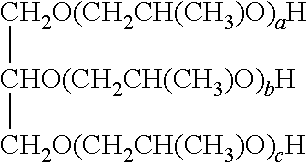Polishing pad and production method thereof
a technology of polishing pad and production method, which is applied in the field of polishing pad, can solve the problems of difficult control of the foaming degree of the polyurethane foam to a desired degree, difficult control of the size of the air bubble, and the study of the polymer matrix when actually used as the polishing pad has not been carried out, so as to achieve excellent polishing stability and high polishing rate. , the effect of excellent slurry retention
- Summary
- Abstract
- Description
- Claims
- Application Information
AI Technical Summary
Benefits of technology
Problems solved by technology
Method used
Image
Examples
example 1
[0098]28.2 parts by weight of polytetramethylene glycol (product of Mitsubishi Chemical Corporation, trade name “PTMG650”) with a number average molecular weight of 650 which had two hydroxyl groups at both ends of a molecule and 21.7 parts by weight of 4,4′-diphenylmethane diisocyanate (product of Sumika Bayer Urethane Co., Ltd., trade name “SUMIDUR 44S”) were charged into a reactor, maintained at 90° C. for 3 hours under agitation so as to react and then cooled so as to obtain a both end isocyanate prepolymer.
[0099]As a crosslinking agent, 21.6 parts by weight of addition reaction product of glycerin and a propylene oxide (product of NOF CORPORATION, trade name “UNIOL TG330”) with a number average molecular weight of 330 which had three hydroxyl groups and 6.9 parts by weight of polytetramethylene glycol “PTMG650” were used. In the crosslinking agent, 14.5 parts by weight of β-cyclodextrin (product of BIO RESEARCH CORPORATION OF YOKOHAMA, trade name “DEXPAL β-100”, average particl...
example 2
[0112]23.1 parts by weight of polytetramethylene glycol (product of BASF Japan Ltd., trade name “PolyTHF250”) with a weight average molecular weight of 250 which had two hydroxyl groups at both ends of a molecule and 46.3 parts by weight of 4,4′-diphenylmethane diisocyanate “SUMIDULE 44S” were charged into a reactor, kept at 90° C. for 3 hours under agitation so as to react and then cooled so as to obtain a both end isocyanate prepolymer.
[0113]As a crosslinking agent, 13.2 parts by weight of “UNIOL TG330” with a number average molecular weight of 330 which had three hydroxyl groups and 17.4 parts by weight of polytetramethylene glycol “PTMG650” were used. In the crosslinking agent, 14.5 parts by weight of β-cyclodextrin “DEXPAL β-100” which was water-soluble particles was dispersed by agitation, and as a curing catalyst, 0.1 parts by weight of 2-methyltriethylenediamine “Me-DABCO” was dissolved by agitation. This mixture was added to the reactor containing the above both end isocyan...
example 3
[0117]A raw material mixture for a polyurethane was obtained in the same manner as in Example 1 except that the amount of β-cyclodextrin “DEXPAL β-100” which was water-soluble particles was changed to 70 parts by weight. Further, a reaction to obtain a polyurethane and post-curing were carried out in the same manner as in Example 1 so as to obtain a polishing pad having a diameter of 60 cm and a thickness of 3 mm. The volume fraction of the water-soluble particles with respect to the whole polishing pad, i.e., the volume fraction of the water-soluble particles with respect to the total of the volumes of the polyurethane matrix and the water-soluble particles, was about 35%.
[0118]The obtained polishing pad showed a tensile product of 1,120 kgf / cm after subjected to a tensile test and a Shore D hardness of 81.
[0119]Further, a polishing rate, the presence or absence of scratches and flatness were evaluated in the same manner as in Example 1. As a result, the polishing rate was 300 nm / m...
PUM
| Property | Measurement | Unit |
|---|---|---|
| particle diameter | aaaaa | aaaaa |
| particle diameter | aaaaa | aaaaa |
| particle diameter | aaaaa | aaaaa |
Abstract
Description
Claims
Application Information
 Login to View More
Login to View More - R&D
- Intellectual Property
- Life Sciences
- Materials
- Tech Scout
- Unparalleled Data Quality
- Higher Quality Content
- 60% Fewer Hallucinations
Browse by: Latest US Patents, China's latest patents, Technical Efficacy Thesaurus, Application Domain, Technology Topic, Popular Technical Reports.
© 2025 PatSnap. All rights reserved.Legal|Privacy policy|Modern Slavery Act Transparency Statement|Sitemap|About US| Contact US: help@patsnap.com

